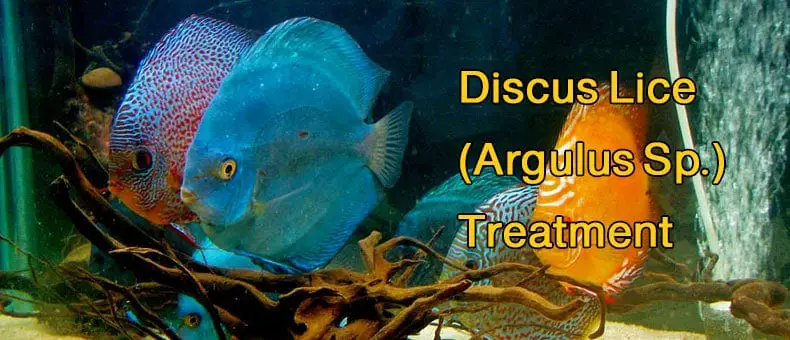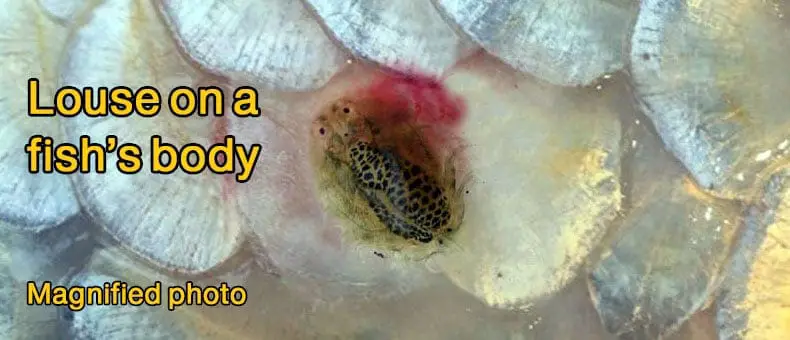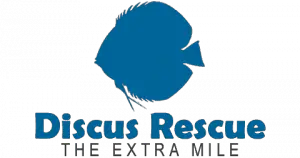
The Argulus sp. is aquarium lice (aka fish lice), which are crustacean ectoparasites of fishes. The hematophagous parasites cling to and feed off the integument of the body of their hosts. They usually grow up to 0.2in (5mm) in diameter, and they are visible to the eyes even without the aid of a microscope. Do not confuse them with algae or dirt.
Table of Contents
- Discus Aquarium Lice Symptoms
- Discus Aquarium Lice Infection Description
- Discus Aquarium Lice Treatment
- Future Prevention Tips For Argulus Control
- Conclusion
Discus Aquarium Lice Symptoms
- Tiny red, brown, or purple spots on the body (pinpoint hemorrhage) caused by bleeding underneath the skin due to the parasites attaching to the body.
- Irregular scale pattern and/or torn fins.
- Swimming erratically, with sudden direction and speed changes.
- Lice itching itself against the tank sides or objects.
- Discus Stress.
- Increased mucous production.
- Discus lethargy.
- Discus Inappetence.
Discus Aquarium Lice Infection Description
One of the rare diseases among the Discus fishes is the Argulus sp or fish lice. They are parasitic in nature, and if left to dwell long in their host, it can cause serious problems and might eventually lead to the death of the Discus fish. These parasites grow as long as 0.2 in (5mm) in diameter.
They result in extreme irritation as its hooks can get into the discus fish’s gills and skin. They will form a Grey-green or brownish slightly raised spots on the fish. On a closer look, you will see the louses eyespots.
Argulids are often irritating and infested Discus scratch themselves on submerged objects or bottom objects to remove the parasite from their bodies. This regular scratching by the Discus is one of the signs of Argulus symptoms.

The parasitic operations of the argulids are so much damaging to the Discus fish. The fish louse has a long stylet and pre-digest the fish tissues and converts it into food for itself.
The more the infestation by this parasite, the more the loss in the physical condition and weakening of the discus fish, thereby causing its immune system to be susceptible to other bacterial and diseases.
Their parasitic activities result in serious inflammation at the point of penetration, thereby causing bacteria and viruses to enter the injured fish. Parasites like leach can use that same spot to feed and cause more damages.
Fish lice could be an early indicator of metal pollution in freshwater.
What Do Fish Lice Look Like?
The fish louse visible to the naked eyes is a broad, flat, oval-shaped body-looking organism with a shell and four legs to aid its swimming. They somehow look like a small brown crab moving fast inside the bottom of the tank.
What Causes Discus Fish Lice?
- Dirty pond or polluted ponds.
- Body to body contact between infested fish and non-infested fish.
- Introduction of unsterilized wild plants to a Discus fish tank.
- Introduction of an infected fish into the aquarium.
Can Fish Lice Harm Humans?
According to some experienced fish keepers, fish lice are not contagious to humans. Nonetheless, it is advisable to handle the sick fish carefully by wearing gloves and sterilizing any equipment used in the aquarium.
The presence of fish lice is a clear indication of a polluted water body, and since humans live all their lives on water usage for several purposes from washing, drinking, etc. so if you are drinking such water, be guaranteed you are taking in harmful substances.
Discus Aquarium Lice Treatment
How Do You Treat Argulus Fish Lice?
To treat Discus lice follow the below 6 steps:
[STEP1] – Do 50% Water Change
Carry out a 50% water change to your Discus tank water.
[STEP2] – Wipe All Aquarium Sides
Wipe down all the sides of the aquarium using a magic sponge.
[STEP3] – Manually Treatment
If the infestation is only one or two lice, then dabbing the louse with a cotton bud that has been dipped in a 50/50 solution of Kerosene and Turpentine.
The louse may still need to be removed with tweezers.
[STEP4] – Treat With A Salt Bath

Can Salt Kill Fish Lice?
For external parasites such as lice, yes it can kill them. A high concentration of salt would be needed up to 20 grams of salt per liter. This will cause the lice and any other parasite to shrink, shrivel, and die.
Not all salt types are recommended for this process as other harmful compounds could be present in them, including unwanted additives also. I recommend sodium chloride, also known as sea salt or magnesium sulfate also known as Epsom salt.
This treatment would be quite salty so do well to thoroughly dissolve the salt in separate water and do not keep the Discus for too long to avoid salt burn at most 10 minutes depending on the concentration, lesser concentration can go as long as 20 minutes.
[1] – Remove 3 gallons (15 liters) of aquarium water into a bucket or a small hospital aquarium
In this case, your fish will be put in the same water parameters and temperature before applying the salt.
[2] – Add the iodine-free table salt
You should use only iodine-free salt to this salt bath following the below ingredients:
17.5 oz (500 grams) per 3 gallons (15 liters) of water you already isolated.
Dissolve the iodine-free salt into the water and wait until the water becomes clear after 2 to 3 minutes.
[3] – Transfer the affected Discus to this water
Transfer your affected Discus fish into the salt bath tank or bucket and leave it swimming there for a maximum of 1 minute before returning it back to the main aquarium tank.
If you find your Discus fish become very week after this treatment, better to put her in a different tank to get a better result for the treatment. But remember to use perfect water conditions in terms of parameters and temperature.
[STEP5] – Treatment With Dipterex (Dylox Neguvon)
After completing the salt bath in step 3, now its time to use Dipterex (Dylox neguvon) medication which is competent in combating lice.
It is advisable to use a dipterex with good potency rate if not the highest. A potency of 98% is perfect for the eradication of discus lies. Nonetheless, if you couldn’t get a high potency leveled dipterex, you will have to calculate how much you require based on the doses below.

Dipterex Dosage
1 milliliter to every (790 – 1320 US gallons) 2990 – 4996 liters of water.
For example, if your aquarium is 50 US gallons, then you should use 0.05 milliliter.
To calculate the proper volume according to your aquarium, use the equation I made for you below taking into consideration the average of the US gallons mentioned above which is around 1000 US gallons:
(X × 0.001 ) = Dipterex Dosage in milliliter.
(X = Your Aquarium volume in US gallons)
[STEP6] – Aquarium Treatment
In an aquarium, the lice drop off the affected Discus normally within two hours. After this happens:
[1] – Move All tank fishes into a mild salt bath
Another salt bath of (two teaspoons per US gallon) of non-iodized salt for a couple of days in a different aquarium.
[2] – Remove all infected aquarium water
Empty the infected aquarium and remove all constraints, plants, sand, rocks …etc.
Boil the non-living stuff like rocks, sands ..etc, and put the live plants in another pouch of water and treat it with some salt in the water.
[3] – Clean all the empty aquarium
Clean all empty aquarium with only water and a magic sponge.
[4] – Clean your filter
Clean the water filter you have with water only. (preferred aged water with no chlorine so good bacteria will not die).
[5] – Prepare the tank again
Put back everything in the tank (without the fishes), fill the tank with water and make it perfect in parameters and temperature till the mild salt bath completed after 2 days.
[6] – Put back the fishes
Put back the whole fishes in the tank and enjoy your hobby.
Future Prevention Tips For Argulus Control
- Feeding the fish with healthy man-made food.
- Change about 25 – 30% of the water level weekly to enhance the water quality.
- Quarantine any new fish before presenting it to the tank to prevent the spread of any potential parasites and other diseases.
- Occasionally wash the aquarium using a magic sponge, especially the edges and hidden corners, to help flush out hidden parasites, bacterial, and fungi.
- Occasionally give the aquarium a salt bath to ease off stress and kill of parasites and bacterial.
Conclusion
Argulus sp., or Discus fish lice, causes stress, lethargy, and inappetence, some of the fish lice symptoms in the Discus fish, but it is not much of a problem when quickly detected, and a simple salt bath can help eradicate this problem along with tank treatment.

